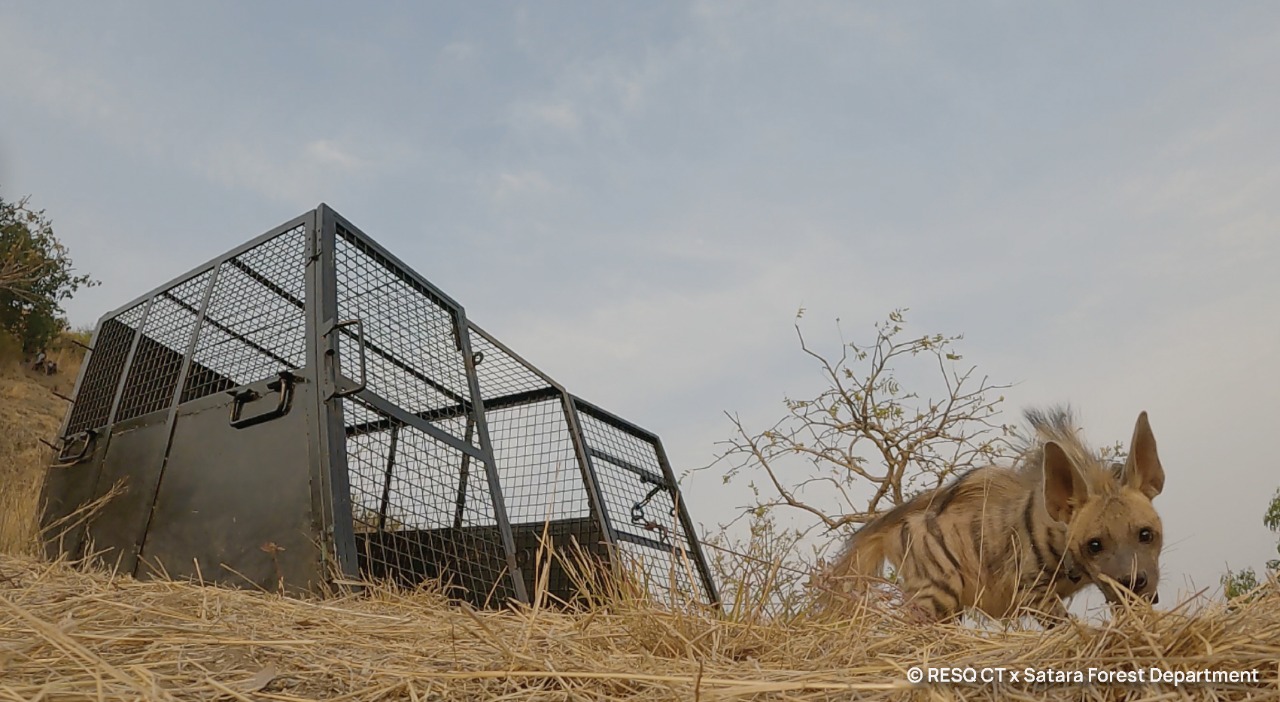Destined To Be Wild: First Indian Striped Hyena raised, rehabilitated and reintroduced into the wild

Pune, 28th April 2022: On 12th April 2022, the RESQ Charitable Trust, Pune team along with the Satara Forest Department collared and reintroduced an Indian Striped Hyena into its natural habitat. She was rescued as a cub, over a year ago, very close to human settlements by the Eco Echo Foundation, Nashik. After their attempts to reunite her with her mother had failed, she was moved to the RESQ Wildlife TTC, Bavdhan, Pune by the Nashik Forest Department for further rehabilitation. She weighed merely 400gms at the time of arrival in Pune.
Bearing a ‘Near Threatened’ status by the IUCN (International Union for the Conservation of Nature), the Indian Striped Hyena and Hyenas, in general, are solitary, and elusive in nature. Many say their population has taken a severe beating due to habitat destruction and retaliatory killings owed to popular beliefs, and it is not uncommon to hear them being poisoned. A highly misunderstood species – they are perceived to be threatening and menacing due to old myths and folklore, making them unwanted amongst human settlements.
Can captive wildlife ever be released into the wild? Katie Moore, Deputy vice-president of the conservation and animal welfare NGO, International Fund for Animal Welfare states, “For the longest time, the idea of returning animals such as large mammals to the wild was just off the table, but now we’re seeing people in the field questioning the long-held belief that it’s impossible to return captive animals to their natural habitat. In a lot of cases, it is still impossible, especially if the animals have been traumatised when young or raised in poor captive conditions. One also needs to be very careful about introducing diseases to a wild population. But if we proceed scientifically and thoughtfully, it can be done.”
“This female Indian Striped Hyena was not destined to just be another wild orphan spending her lifetime in the captivity of a zoo. We knew our goal from day one, we had to keep her wild in order for her to have any chance of future survival in a natural habitat,” says Harshad Nagare, one of her primary handlers in her early days at RESQ CT.
For this cub, an exhaustive list of rehabilitation milestones was formulated, which she had to complete over the next year. As she grew bigger, she moved through enclosures of different sizes, with varied enrichment which encouraged igniting her wild instincts of den-making, digging, marking her territory, and hiding food. She was exposed to varying qualities of feed and water, subjected to scarcities and weathered different climate conditions over the last year. Right from when she started self-feeding we began the process of desensitising her to human approach or contact because her distrust towards humans is imperative for her survival in the wild. The plan was to GPS collar her so that her movements can be monitored post-release.
Amit Sayyed, Wildlife Researcher and Founder of WLPRS (Wild Life Protection and Research Society) directed us to an area near Satara that was rich in wildlife and sufficiently distant from human settlements. The Range Forest Officer of that range Nivrutti Chavhan and Madhav Mohite (IFS), Deputy Conservator of Forests, Satara visited the RESQ Centre and observed the Hyena’s wild behaviour.
DCF Madhav Mohite said, “The hyena darted away into hiding as soon as we approached the enclosure. She did not even come out for the people who had raised her. She appeared healthy, active, alert and wild. We have a lot of areas in our division where wildlife thrives without being in conflict with humans. The RESQ team had already put in a lot of effort into the rehabilitation of this hyena, they were willing to GPS collar it for monitoring purposes, our local forest department team was enthusiastic about taking the initiative and so we were happy to provide any further support needed for this hyena’s future. Once the team indicated that she would be ready for release at 12-14 months of age, I sought permission for her release from the Principal Chief Conservator of Forests (Wildlife), Maharashtra,” said Mohite.
After one year of intensive rehabilitation, she had gone from weighing 400 grams when she arrived to 20 kgs at the time of release. She had met her rehabilitation milestones and was mature enough to be reintroduced into the wild. Dr. José Vicente López-Bao, CSIC Senior Research Scientist from Biodiversity Research Institute (IMIB) Spain assisted the RESQ team with providing the GPS collar.
On the reintroduction site, Tuhin Satarkar, Field Director, RESQ, recounts, “As she stepped out of her cage towards freedom, the entire team was anxious about her future. We continued to closely monitor her. Initially, for the first day, she remained in a 600-meter range of her release location. But from Day 2 onwards, she began exploring the environs. Our teams stayed in the area for 10 days post-release, tracking her movements using thermal drones, camera traps and surveying the area on foot. Today marks a successful 14 days of her survival in the wild. While reviewing the camera trap footage over the last few weeks, what we see in the videos is a confident female walking by. We are relieved at her progress and quite convinced that she has found food and the means to keep herself safe. The first two weeks were critical because it is the summer and we want to make sure she has settled in properly before the monsoon arrives.”
“This has never been done before, and while we are at a nascent stage of rethinking old ideas about reintroduction, there is yet much to learn.”, says Neha Panchamia, Founder, RESQ Charitable Trust, Pune. She adds, “Her survival holding testimony, she could become the torchbearer for the future of hundreds of relatively non-conflict wild orphans – maybe they can be successfully reintroduced to the wild instead of spending their lifetimes in captivity. The fate of wildlife is already threatened due to ever-increasing urban development, climate change and shifts in agricultural patterns in human-dominated landscapes. In addition to that, institutions are struggling due to a lack of space to intake animals in lifetime care. If we don’t push boundaries now, we will never know if these orphan animals that are generally sent into lifetime captivity, ever stood a chance back in the wild.”
DCF Madhav Mohite, Satara said, “We are proud to have released India’s first captive-raised Striped Hyena in our division. Our local forest officers and the RESQ team are monitoring her and the area actively. Previously wild orphans would either not survive or just be sent to rescue centres or zoos, it is good that we can now consider another option of reintroducing them back to the wild, at least for some non-conflict wildlife species.”






